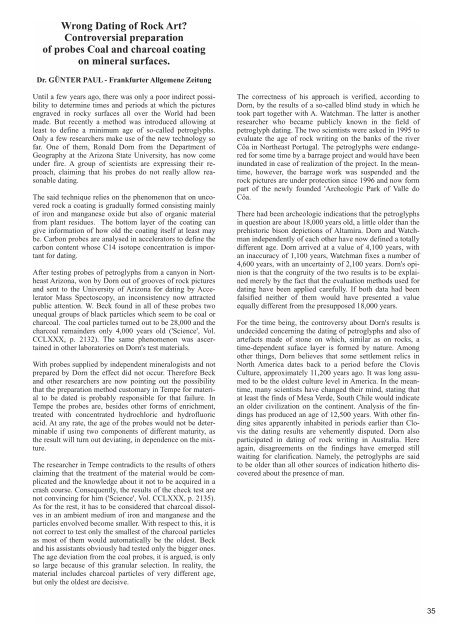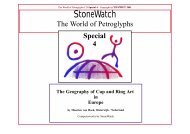Monts des Ksour" im Süd-Oranais / Nord-Algerien - StoneWatch
Monts des Ksour" im Süd-Oranais / Nord-Algerien - StoneWatch
Monts des Ksour" im Süd-Oranais / Nord-Algerien - StoneWatch
Erfolgreiche ePaper selbst erstellen
Machen Sie aus Ihren PDF Publikationen ein blätterbares Flipbook mit unserer einzigartigen Google optimierten e-Paper Software.
Wrong Dating of Rock Art?<br />
Controversial preparation<br />
of probes Coal and charcoal coating<br />
on mineral surfaces.<br />
Dr. GÜNTER PAUL - Frankfurter Allgemene Zeitung<br />
Until a few years ago, there was only a poor indirect possibility<br />
to determine t<strong>im</strong>es and periods at which the pictures<br />
engraved in rocky surfaces all over the World had been<br />
made. But recently a method was introduced allowing at<br />
least to define a min<strong>im</strong>um age of so-called petroglyphs.<br />
Only a few researchers make use of the new technology so<br />
far. One of them, Ronald Dorn from the Department of<br />
Geography at the Arizona State University, has now come<br />
under fire. A group of scientists are expressing their reproach,<br />
cla<strong>im</strong>ing that his probes do not really allow reasonable<br />
dating.<br />
The said technique relies on the phenomenon that on uncovered<br />
rock a coating is gradually formed consisting mainly<br />
of iron and manganese oxide but also of organic material<br />
from plant residues. The bottom layer of the coating can<br />
give information of how old the coating itself at least may<br />
be. Carbon probes are analysed in accelerators to define the<br />
carbon content whose C14 isotope concentration is <strong>im</strong>portant<br />
for dating.<br />
After testing probes of petroglyphs from a canyon in Northeast<br />
Arizona, won by Dorn out of grooves of rock pictures<br />
and sent to the University of Arizona for dating by Accelerator<br />
Mass Spectoscopy, an inconsistency now attracted<br />
public attention. W. Beck found in all of these probes two<br />
unequal groups of black particles which seem to be coal or<br />
charcoal. The coal particles turned out to be 28,000 and the<br />
charcoal remainders only 4,000 years old ('Science', Vol.<br />
CCLXXX, p. 2132). The same phenomenon was ascertained<br />
in other laboratories on Dorn's test materials.<br />
With probes supplied by independent mineralogists and not<br />
prepared by Dorn the effect did not occur. Therefore Beck<br />
and other researchers are now pointing out the possibility<br />
that the preparation method customary in Tempe for material<br />
to be dated is probably responsible for that failure. In<br />
Tempe the probes are, besi<strong>des</strong> other forms of enrichment,<br />
treated with concentrated hydrochloric and hydrofluoric<br />
acid. At any rate, the age of the probes would not be determinable<br />
if using two components of different maturity, as<br />
the result will turn out deviating, in dependence on the mixture.<br />
The researcher in Tempe contradicts to the results of others<br />
cla<strong>im</strong>ing that the treatment of the material would be complicated<br />
and the knowledge about it not to be acquired in a<br />
crash course. Consequently, the results of the check test are<br />
not convincing for h<strong>im</strong> ('Science', Vol. CCLXXX, p. 2135).<br />
As for the rest, it has to be considered that charcoal dissolves<br />
in an ambient medium of iron and manganese and the<br />
particles envolved become smaller. With respect to this, it is<br />
not correct to test only the smallest of the charcoal particles<br />
as most of them would automatically be the ol<strong>des</strong>t. Beck<br />
and his assistants obviously had tested only the bigger ones.<br />
The age deviation from the coal probes, it is argued, is only<br />
so large because of this granular selection. In reality, the<br />
material inclu<strong>des</strong> charcoal particles of very different age,<br />
but only the ol<strong>des</strong>t are decisive.<br />
The correctness of his approach is verified, according to<br />
Dorn, by the results of a so-called blind study in which he<br />
took part together with A. Watchman. The latter is another<br />
researcher who became publicly known in the field of<br />
petroglyph dating. The two scientists were asked in 1995 to<br />
evaluate the age of rock writing on the banks of the river<br />
Côa in Northeast Portugal. The petroglyphs were endangered<br />
for some t<strong>im</strong>e by a barrage project and would have been<br />
inundated in case of realization of the project. In the meant<strong>im</strong>e,<br />
however, the barrage work was suspended and the<br />
rock pictures are under protection since 1996 and now form<br />
part of the newly founded 'Archeologic Park of Valle do<br />
Côa.<br />
There had been archeologic indications that the petroglyphs<br />
in question are about 18,000 years old, a little older than the<br />
prehistoric bison depictions of Altamira. Dorn and Watchman<br />
independently of each other have now defined a totally<br />
different age. Dorn arrived at a value of 4,100 years, with<br />
an inaccuracy of 1,100 years, Watchman fixes a number of<br />
4,600 years, with an uncertainty of 2,100 years. Dorn's opinion<br />
is that the congruity of the two results is to be explained<br />
merely by the fact that the evaluation methods used for<br />
dating have been applied carefully. If both data had been<br />
falsified neither of them would have presented a value<br />
equally different from the presupposed 18,000 years.<br />
For the t<strong>im</strong>e being, the controversy about Dorn's results is<br />
undecided concerning the dating of petroglyphs and also of<br />
artefacts made of stone on which, s<strong>im</strong>ilar as on rocks, a<br />
t<strong>im</strong>e-dependent suface layer is formed by nature. Among<br />
other things, Dorn believes that some settlement relics in<br />
North America dates back to a period before the Clovis<br />
Culture, approx<strong>im</strong>ately 11,200 years ago. It was long assumed<br />
to be the ol<strong>des</strong>t culture level in America. In the meant<strong>im</strong>e,<br />
many scientists have changed their mind, stating that<br />
at least the finds of Mesa Verde, South Chile would indicate<br />
an older civilization on the continent. Analysis of the findings<br />
has produced an age of 12,500 years. With other finding<br />
sites apparently inhabited in periods earlier than Clovis<br />
the dating results are vehemently disputed. Dorn also<br />
participated in dating of rock writing in Australia. Here<br />
again, disagreements on the findings have emerged still<br />
waiting for clarification. Namely, the petroglyphs are said<br />
to be older than all other sources of indication hitherto discovered<br />
about the presence of man.<br />
35
















